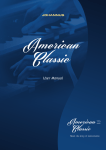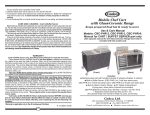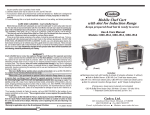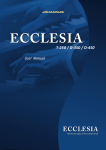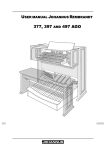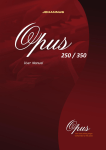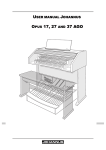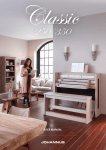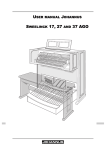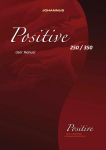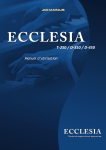Download User Manual $*2
Transcript
the JOHANNUS revolution User Manual$*2 The church organ without compromise JOH_Manual A4 ECCLESIA.indd 1 14-04-10 13:54 Ecclesia D-47 Manufacturer Johannus Orgelbouw b.v Address Keplerlaan 2 6716 BS EDE Country The Netherlands Telephone +31 (0)318 63 74 03 Fax +31 (0)318 62 22 38 E-mail [email protected] Website www.johannus.com Version 1.0 Date August 2010 . © 2010, Johannus Orgelbouw b.v. All rights reserved. Nothing in this publication may be reproduced, stored in a computerised data file or made public in any form or in any way either electronically, mechanically, by way of photocopying, recording or in any other manner without prior written permission from Johannus Orgelbouw b.v. the JOHANNUS revolution Ecclesia D-47 Table of contents Safety Safety precautions Symbols on the organ Symbols in the manual 1 1 1 Installation Installation and connection Switching on Transport and storage Opening and closing the rolltop cover 1 1 1 1 Description of the Organ Overview of the main components Overview of display Overview of controls Connect and switch on the peripherals External connections 1 1 2 3 3 Operation Volume Controls Expression pedals Adaptive Surround Reverb Intonations Factory intonation settings Orchestrals Stops Couplers Accessories Change the registration Pre-programmed memory locations Capture memory Transposer General Crescendo 1 1 1 2 2 3 3 4 4 5 5 5 6 6 Easy Menu Orchestrals MIDI Tuning Temperaments Keyboard Config Reset Procedures Datadump Startup settings Reverb Key Volumes 1 2 2 2 3 4 4 5 5 5 the JOHANNUS revolution Table of contents - 1 - Table of contents Maintenance Overview Cabinet maintenance Maintenance of the manuals Problems Reposition the pedal Warranty 1 1 1 1 2 2 MIDI Implementations MIDI Implementation Chart MIDI specifications 1 2 the JOHANNUS revolution Table of contents - 2 - Safety SAFETY Safety precautions Place the organ on a stable, horizontal surface. Connect the organ to an electrical outlet with an earth connection. Switch the organ off when it is not in use. Do not place the organ in a damp area. Do not expose the organ to liquids. Follow the instructions and precautionary measures in this user manual. Keep this user manual with the organ. The organ may only be opened by a technician authorised by Johannus Orgelbouw b.v. The organ contains static-sensitive components. The warranty becomes null and void if the organ is opened by a non-authorised person Symbols on the organ Warning Warning for electric shock Warning for static-sensitive components Symbols in the manual Warning or important information Note the JOHANNUS revolution Safety - 1 - Installation Installation and connection 1. 2. 3. 4. 5. 6. 7. 8. Position the organ on a stable, horizontal surface. Lean the organ slightly backward. Slide the pedal (A) against the pedalboard of the organ (B). Set the organ upright. Place the music desk (C) using the music desk supports in both holes in the stop panel. Place the organ bench over the pedal. Make sure the voltage of the organ matches the voltage of the mains. See the serial plate (D). Connect the organ to an earthed power socket. Switching on Switch on the organ with the on/off key switch on the right next to the manuals. Wait several seconds. Starting the control functions and the settings will take some time. The lamps of the SET and 0 piston light up and the settings appear on the display. Transport and storage Pay attention to the following during transport and storage: Remove the music desk and the pedalboard from the organ. Relative humidity within the storage area: 10 to 90%. Opening and closing the rolltop cover The organ can be closed with a wooden rolltop cover that has a lock. The rolltop cover lock is behind the music desk. Opening 1. Put the appropriate key in the rolltop cover lock. 2. Turn the key a quarter turn to the left. The lock now rises out of the rolltop. 3. Slide the rolltop cover upward. Closing Never leave the key in the area that can be closed. 1. 2. 3. Slide the rolltop cover downward. Press the rolltop cover lock in. Turn the key a quarter turn to the right. the JOHANNUS revolution Installation - 1 - Description of the Organ Overview of the main components A Music desk B Music desk C Pistons D General Crescendo pedal E Swell shoes F Organ bench G Pedal Overview of display A Product name B Volume C Selected memory bank D Tuning setting E Transposer setting F Temperament setting G Crescendo setting H Swells indicators the JOHANNUS revolution Desciption of the organ - 1 - Description of the Organ Overview of controls A B C D E F G H I J K L M N O P Q R Pedal stops Swell stops Main group intonations Sub group intonations Pre-programmed memory locations Memory bank Swell Display Rolltop cover lock Manual Swell Solo instruments (Optional) Manual great Manual choir All swell to swell piston REC piston Great stops Choir stops On/Off switch Organ volume knob JOHANNUS revolution the S T U V W X Y Z AA BB CC DD EE FF GG HH II Reverb volume knob SEQ piston SET piston Memory bank generals Memory bank pedal Keyboard Transfer piston Crescendo piston Memory bank great Memory bank choir Keyboard instruments (Optional) Accessories +/- pistons RO piston MENU piston CAN piston TUTTI piston Memory keylock Desciption of the organ ‐ 2 ‐ Description of the Organ Connect and switch on the peripherals You can connect accessories (for example, a MIDI device) to the organ. Follow the instructions provided in the documentation for the accessory. 1. 2. 3. 4. Switch off the organ and the accessory. Connect the accessory to the organ. Switch the accessory on. Switch on the organ External connections The external connections are on the left under the console. MIDI IN: This is an input for receiving MIDI codes from other devices. MIDI MOD.: This is a programmable MIDI output for connecting a module or expander, for example. MIDI SEQ.: This is a non-programmable MIDI output for connecting a sequencer or PC (with the optional Johannus Intonat program), for example. AUX IN: This is a (stereo) input for playing the sound of an external device through the amplifiers of the organ. For example, an expander connected to the organ through the MIDI MOD. can be played through the instrument's loudspeakers. The volume of the device that is connected through the AUX IN cannot be adjusted with the general volume or the swell shoes. However, this is possible when the volume setting of the external device is controlled by means of MIDI codes through the MIDI MOD. connection of the instrument. AUX OUT: This is an output for connecting an external (stereo) amplifier. EXT. REV.: This is an output for connecting Johannus external acoustics. This is a system that imitates the spatial effect of a concert hall or cathedral. Do not use these outputs for other purposes. PHONES: This connection for a (stereo) headphone is suited for a headphone with an impedance of 30 Ω or more (see headphone specifications). When the headphone is used, the internal and/or external loudspeakers of the organ are switched off automatically. JOHANNUS revolution the Desciption of the organ ‐ 3 ‐ Operation Volume Controls Organ: You can adjust the overall volume of the organ with the ORGAN VOLUME control. Acoustics: The acoustics volume can be continuously adjusted using the ACOUSTICS VOL. control. Expression pedals Expression pedals control the volume of Great/Pedal, the Swell and the Choir. Adaptive Surround Reverb Adaptive Surround Reverb offers you the possibility of choosing your own acoustic environment. You have a choice of no less than 12 unique reverbs, allowing you to choose a different reverb for each style and intonation. Your organ comes with the following standard settings: Romantic Symfonic Baroque Historic Town Church Concert Hall Village Chapel Royal Auditorium Other reverb options: Basilica Music Room City Cathedral Abbey Church Hill Church Marble Church Palace Hall Marble Room When changing style and/or intonation, the chosen style, intonation and reverb will be shown briefly on the display. Volume Turn the VOLUME knob to change the volume of the reverb. Length Turn the LENGTH knob to change the length of the reverb. The length can be set per reverb. For each reverb the last setting is saved. Reverb You can choose from 12 different reverbs. You can alter these per style and intonation. 1. Use the ROM, SYM, BAR (Style), SOLO and TRIO (intonation) knobs to activate the style and intonation you wish to change the reverb for. 2. Press the MENU button. 3. Use the + and – buttons to obtain the desired reverb. 4. Push the SET button. The selected reverb has now been stored in memory. The ‘3D Surround On/Off’ option will now appear on the display. 5. Use the + and – buttons to turn the 3D Surround on or off. 6. Press the SET knob. The selected 3D Surround setting has now been stored in memory and will automatically appear in the main menu. 7. Press the MENU button to leave the Easy Menu. the JOHANNUS revolution Operation - 1 - Operation Intonations The intonations group consist of: Romantic (ROM.) Symphonic (SYM.) Baroque (BAR.) Historic (HIS.) The subgroup consists of: Classic SOLO TRIO 1. 2. Select a main group by pressing the ROM, SYM, BAR or HIS piston. Then select a subgroup by pressing the SOLO or TRIO piston. If no subgroup is selected, Classic will be selected automatically. Factory intonation settings Save the intonation settings The Johannus intonation program is required for saving the intonation settings. 1. 2. Connect a PC to the organ. Use the MIDI SEQ. output. Save the intonation settings on the PC using the Johannus intonation program. Restore the factory intonation settings The current intonation settings will be lost if the settings are not saved on a PC. 1. 2. 3. 4. 5. Switch off the organ. Press buttons 1 and 8. Hold the buttons. Switch on the organ. Wait until the lamp in the 0 button lights up. Release buttons 1 and 8. the JOHANNUS revolution Operation - 2 - Operation Orchestrals This function only available in the Solo Voice Package and Ultimate Voice Package Orchestrals are high-quality, classical instrument voices especially for playing key instruments and/or solos. Possible options are: Solo Voice Package and Ultimate Voice Package Chimes : Chimes, Carillon or Orchestral Chimes Flute : Flute, Piccolo or Recorder Panflute : Panflute, Chrysoglott or Handbells Tuba : Tuba, Horn or Timpani Trumpet : Trumpet, Trumpet alternate or Ranket 8’ Oboe : Oboe, Oboe alternate or Choir 1 Clarinet : Clarinet, Clarinet alternate or Choir 2 1) 2) 3) 4) Ultimate Voice Package only Gospel Organ 3) 4) : Gospel Full Organ, Tibia Organ or Reed Organ Jazz Organ : Gospel Jazz Organ, Gospel Organ 1 or Gospel Organ 2 Piano 2) : Piano, Electronic Piano 1 or Electronic Piano 2 Harp : Harp, Glassharp or Woodharp Harpsichord : Harpsichord, Celesta 1 or Celesta 2 Strings 1) : Strings, Bell Strings or Warm Strings If the manual on which the Strings is played has been linked with the pedal, the Contrabass will also sound through the pedal. When the piano is activated, the pedal can only be played from C - e (the first 17 keys). The F sharp key of the pedal is given the function of the sustain pedal and the F key can be used as a rest for the right foot for proper operation of the sustain pedal. The display will briefly show this pedal switch as a message. When linking the manual on which the Gospel Organ can be played to the pedal, the Gospel Organ bass stop will sound through the pedal. The Leslie only has an effect on the Gospel Organ. If the Leslie Effect has not been activated, the (slow) chorus effect will be heard on the Gospel Organ. If the Leslie Effect has been activated, the (fast) tremolo effect will be heard on the Gospel Organ. Most Orchestrals can by default be played on the Great. The Strings can by default be played on the Swell. The Harpsichord and the Chimes can by default be played on the Choir. Stops The stops are activated using rocker switches or through the capture memory. The lamp in the rocker switch is on when the corresponding stop is active. The stops have been divided into four groups: Pedal: Enables the stops associated with the Pedal. Choir: Enables the stops associated with the Choir. Great: Enables the stops associated with the Great. Swell: Enables the stops associated with the Swell. the JOHANNUS revolution Operation - 3 - Operation Couplers Manual couplers: Swell – Choir: Fully couples all keys of the Swell to the Choir. Swell – Great: Fully couples all keys of the Swell to the Great. Choir – Great: Fully couples all keys of the Choir to the Great. Pedal couplers: Choir – Pedal: Fully couples all keys of the Choir to the Pedal. Great – Pedal: Fully couples all keys of the Great to the Pedal. Swell – Pedal: Fully couples all keys of the Swell to the Pedal. Manual Bass (MB): Couples the pedal monophonically to the Great. Only the lowest note played on the Great is coupled from the pedal to the Great. Enable the Manual Bass using the MB button. If only the lowest tone of a chord is released, the tone activated by the MB mode is lost until a new lowest tone is played. This should prevent annoying ‘jumping’ of the MB tones. Cantus Firmus (CF): Couples the Swell monophonically to the Great. Only the highest tone played on the Swell is coupled to the Great. Enable the Cantus Firmus using the CF button. If only the highest tone of a chord is released, the tone activated by the CF mode is lost until a new highest tone is played. This should prevent annoying ‘jumping’ of the CF tones. Keyboard transfer: Stop on the Choir switching the manual with the Great manual. The stops on the Choir can now be played on the Great manual and the stops on the Great can be played on the Choir manual. Accessories Chorus (CH): Is a mode for slightly detuning the organ stops for a broader and livelier sound. Use the CH button to activate the Chorus. Fix Accessories (FA): This is a mode for fixing accessories. As long as this button is enabled, the couplers and tremulants can only be switched on and off manually. Reeds Off (RO): This is a mode for switching off all reeds at once . No reeds can be enabled as long as this button is pressed. When switching off this mode, the reeds that were on are activated again. Enable the Reeds Off mode using the RO button. General Crescendo pedal (CR): This is a mode for switching the General Crescendo pedal on and off. All Swells to Swell (S/S): This mode replaces all swells with one swell, being the swell of the Swell. the JOHANNUS revolution Operation - 4 - Operation Change the registration The REC and CAN pistons cancel registrations at two levels: Press the REC piston: Only the last change is cancelled. Press the CAN piston: All registrations are cancelled. Preprogrammed memory locations Pre-programmed memory locations are available through the operating buttons PP to T. These six memory locations have factory settings (presets) appropriate for the quiet pianissimo to the loud tutti. Retrieve a preprogrammed memory location 1. Press a pre-programmed memory location (PP-T). The active stops light up. Programme a preprogrammed memory location The current setting of the pre-programmed memory location will be lost. Programming the pre-programmed memory location is limited to the text on the button. For example, it is not advisable to programme a pianissimo registration under the tutti button. 1. 2. 3. 4. 5. Select the required stops. Press the SET button. Hold the button. Press the required pre-programmed memory location (PP-T). Release the pre-programmed memory location button (PP-T). Release the SET button. Capture memory Using the capture memory, a registration can be activated with one button. The capture memory consists of eight levels. Each level has eight memory locations. These levels are shown on the display (Mem:..). The capture memory locations are initially empty and for the user to be programmed. Programme a capture memory location The current setting of the capture memory location will be lost. 1. 2. 3. 4. 5. Select the required stops. Select a level (1-32) on the display using the - and + buttons. Press the SET button. Hold the button. Press the required memory location (1-8). Release the SET button. Retrieve a capture memory location 1. 2. Use the - and + buttons to select the required level (1-32) on the display. Press the required memory location (1-8). The active stops light up. the JOHANNUS revolution Operation - 5 - Operation With the SEQ- and SEQ+ buttons you can select a lower or higher (respectively) memory location in steps of one. The lit capture button and the display indicate which memory location has been selected. Transposer The Transposer mode shifts the pitch by half-tone increments (from -8 to +8). The set pitch can be read on the display (Trans:..). The pitch can only be programmed when the TRANS. button is lit. Change the transposer 1. 2. Press the TRANS. button. Set the pitch using the - and + buttons. The pitch shift is not stored in memory. When the organ is switched on again, the most recently programmed pitch will be active. Programme the transposer 1. 2. 3. Press the TRANS. button. Set the pitch using the - and + buttons. Press the SET button. The pitch change is stored in memory. When the organ is switched on again, the programmed pitch will be active. General Crescendo The General Crescendo pedal can be used to activate different registrations step-by-step. These registrations start with very quiet (pianissimo) to very loud (tutti). Activate the General Crescendo pedal When the General Crescendo pedal has not been enabled, the display shows the message Cresc: Off. 1. Press the CR button to enable the General Crescendo pedal. The display indicates which step has been set. Change the General Crescendo pedal The by default set stop combinations of the crescendo steps can be changed and saved in the memory. Only step 0 cannot be changed. 1. 2. 3. 4. 5. 6. 7. First press the CR button, then the MENU button. Use the - and + buttons to select the step to be changed. Set the required registration for the step. Press the SET button. If necessary, select another step to be changed. Press the MENU button to switch off the programming mode. Press the CR button to switch off the General Crescendo mode. the JOHANNUS revolution Operation - 6 - Easy Menu The Easy Menu is an operating system the settings of which can be read on the display. The Easy Menu is operated with the - and + buttons and the SET and the MENU buttons. The Easy Menu consists of the following modes: Crescendo Datadump Demo Songs Keyboard Config Key Volumes MIDI Config Orchestrals Reset Procedures Reverb Settings Startup Settings Temperaments Tuning Zimbelstern Settings The menu has a scrollbar on the right. It indicates where you are in the menu. If you can go further down in the menu, there is a down arrow in the bottom of the scrollbar. If you can go further up in the menu, there is an up arrow in the top of the scrollbar. Crescendo 1. 2. 3. 4. 5. 6. 7. Press the MENU piston. Use the - and + pistons to select the Crescendo mode on the display and press SET. Use the - and + pistons to select the step to be changed. Change the registration by switching a register on or off. Press SET to save the registration. Press the MENU piston to exit the Crescendo menu. Press the MENU piston again to exit the Easy Menu Datadump The Datadump Mode sends settings from the organ to a storage medium (for example a sequencer) through the MIDI SEQ. output. See §3.4. 1. 2. 3. 4. 5. Press the MENU piston. Use the - and + pistons to select the Datadump on the display. Press the SET piston. The following text appears in the display: Press SET to send data. Make sure the desired storage medium is properly connected. Press the SET piston again. When data is being sent, Sending data appears on the display. As long as Sending data appears in the display, you cannot use the organ. 6. Press the MENU piston to exit the Easy Menu. the JOHANNUS revolution Easy Menu - 1 - Easy Menu Demo Songs The Demo Songs mode plays thirteen different demo songs. 1. Press the MENU piston. 2. Use the - and + pistons to select the Demo Songs function. 3. Press the SET piston. The title and composer of the first demo song appear on the display. 4. Use the - and + pistons to select one of the thirteen demo songs. 5. Press the SET piston to select a demo song. 6. Use the - and + pistons to choose whether to play the selected demo song (play one) or all demo songs (play all). 7. Press the SET piston to start playing the selected demo song(s). a. Press the CAN piston to stop playing the demo song. b. Use the Organ volume control to adjust the volume before or while playing the demo song. c. Use the Acoustics volume control to adjust the acoustics volume before or while playing the demo song. 8. Press the MENU piston after having played the demo song(s). You will automatically return to the main menu. 9. Press the MENU piston again to exit the Easy Menu. Keyboard Config The Keyboard Config mode sets the operation of the keys. This mode is not available on organs with wooden keyboards. 1. 2. 3. 4. Press the MENU piston. Use the - and + pistons to select the Keyboard Config function on the display. Press the SET piston. Use the - and + pistons to select the manual the setting of which must be changed. Choir: Choir Great: Great Swell: Swell 5. 6. Press the SET piston. Use the - and + pistons to select a setting for the operation of the keys. Automatic: The manual has been set to High. When activating a programmable MIDI or Orchestral stop, the manual will be set to Velocity automatically. High: The keys respond when touched very lightly. Low: The keys respond when pressed further. Velocity: The keys are force-sensitive. 7. Press the SET piston. The manual setting is now saved in the memory. Press the MENU piston to return to the main menu. Press the MENU piston again to exit the Easy Menu. 8. 9. the JOHANNUS revolution Easy Menu - 2 - Easy Menu Key Volumes If you are asked to enter a PIN code, the Key Volumes mode has been secured at the request of the owner. Contact the owner or dealer to retrieve the PIN code. Enter the code using the pistons of the capture memory and press the SET piston. The Key Volumes mode consists of the following submodes: Adjust Reset one stop Reset ALL stops Adjust: The Adjust mode sets the volume per key, stop and intonation. 1. Switch off all stops. 2. Select an intonation. 3. Press the MENU piston. 4. Use the - and + pistons to select the Key Volumes function on the display. 5. Press the SET piston. 6. Use the - and + pistons to select the Adjust function on the display. 7. Press the SET piston. 8. Activate one stop. 9. Press one key on the corresponding division and hold the key. The display will now show following Key: the key indicator and following Volume: the volume. 10. Use the - and + pistons to set the desired volume. 11. Press the SET piston after having changed one or more keys. 12. The display shows a prompt for confirmation. Use the - and + pistons to select No or Yes. 13. Press the SET piston for confirmation. 14. Press the MENU piston to return to the main menu. 15. If the change has not been saved, the display will show Discard changes?. Use the and + pistons for Yes and press the SET piston to cancel the changes. 16. Press the MENU piston twice to exit the Easy Menu. Reset one stop: The Reset one stop mode resets the key volumes for one stop in one intonation to the factory setting. 1. Switch off all stops. 2. Select an intonation. 3. Press the MENU piston. 4. Use the - and + pistons to select the Key Volumes function on the display. 5. Press the SET piston. 6. Use the - and + pistons to select the Reset one stop function on the display. 7. Press the SET piston. 8. Activate one stop. 9. The display shows a prompt for confirmation. Use the - and + pistons to select No or Yes. 10. Press the SET piston. 11. Press the MENU piston twice to exit the Easy Menu. the JOHANNUS revolution Easy Menu - 3 - Easy Menu Reset ALL stops: The Reset ALL stops mode resets the key volumes of all stops in one intonation to the factory setting. 1. Select an intonation. 2. Press the MENU piston. 3. Use the - and + pistons to select the Key Volumes function on the display. 4. Press the SET piston. 5. Use the - and + pistons to select the Reset ALL stops function on the display. 6. Press the SET piston. 7. The display shows a prompt for confirmation. Use the - and + pistons to select No or Yes. 8. Press the SET piston. 9. Press the MENU piston twice to exit the Easy Menu. MIDI Config MIDI is a protocol for communication between the organ and other devices, such as: PC Sequencer Other musical instruments Programming MIDI Config The programmable MIDI stops allow you to control any module voice through any MIDI channel (1-16). 1. Press the MENU piston. 2. Use the - and + pistons to select the MIDI Config mode on the display. 3. Press the SET piston. The display shows the text Manual: and the text Channel MSB LSB Voice below this. 4. Select the MIDI stop to be programmed (for example MIDI III). The display will now show following Manual: the selected keyboard and the selected settings below the text Channel MSB LSB Voice. The arrow preceding the number indicates the setting that can be changed. 5. Use the - and + pistons to select the desired MIDI channel (Channel). 6. Press the SET piston. The arrow now goes to the next setting: MSB. 7. If necessary, use the - and + pistons to select the required MIDI channel (Channel). 8. Press the SET piston. The arrow now goes to the next setting: LSB. 9. If necessary, use the - and + pistons to select the required LSB value (LSB). 10. Press the SET piston. The arrow now goes to the next setting: Voice 11. Use the - and + pistons to select the desired module voice Voice value (Voice). 12. Press the SET piston to save the change. 13. Select another MIDI stops to be programmed, if required. 14. Press the MENU piston to return to the main menu. 15. Press the MENU piston again to exit the Easy Menu. the JOHANNUS revolution Easy Menu - 4 - Easy Menu Orchestrals (Optional) The Orchestrals mode sets the voices per manual. Programming Orchestrals 1. 2. 3. 4. 5. 6. 7. 8. 9. 10. Press the MENU piston. Use the - and + pistons to select the Orchestrals mode on the display. Press the SET piston. In the display, a list of Orchestrals will appear. Use the - and + pistons to select the desired voice. Press the SET piston. Use the - and + pistons to select the alternative you wish to use. Press a key on the manual for which you wish to use this voice. Your choice will be displayed in the menu. Press the SET piston. The selected setting is saved in the memory and you automatically return to the menu. Press the MENU piston to return to the main menu. Press the MENU piston again to exit the Easy Menu. You can choose from the following voices with corresponding alternatives: Solo Voice Package and Ultimate Voice Package Chimes : Chimes, Carillon or Orchestral Chimes Flute : Flute, Piccolo or Recorder Panflute : Panflute, Chrysoglott or Handbells Tuba : Tuba, Horn or Timpani Trumpet : Trumpet, Trumpet alternate or Ranket 8’ Oboe : Oboe, Oboe alternate or Choir 1 Clarinet : Clarinet, Clarinet alternate or Choir 2 Ultimate Voice Package only Gospel Full Organ : Gospel Full Organ, Tibia Organ or Reed Organ Gospel Jazz Organ : Gospel Jazz Organ, Gospel Organ 1 or Gospel Organ 2 Piano : Piano, Electronic Piano 1 or Electronic Piano 2 Harp : Harp, Glassharp or Woodharp Harpsichord : Harpsichord, Celesta 1 or Celesta 2 Strings : Strings, Bell Strings or Warm Strings Reset Procedures The Reset Procedures mode is used to delete the capture memory or to reset some settings to the factory settings. 1. Press the MENU piston. 2. Use the - and + pistons to select the Reset Procedures function on the display. 3. Press the SET piston. The display shows the menu for the Reset Procedures. 4. Use the - and + pistons to select the desired procedure. Crescendo default Cust. Temperament def. Memory default Midi default Orchestrals default Preset default Reverb Program default Special Stop mode def. Tracker Action default Tweeter Volume default 5. Press the SET piston. The display shows a prompt for confirmation. 6. Use the - and + pistons to select No or Yes. the JOHANNUS revolution Easy Menu - 5 - Easy Menu 7. 8. 9. Press the SET piston for confirmation. Press the MENU piston to return to the main menu. Press the MENU piston again to exit the Easy Menu. Reverb Settings 1. 2. 3. 4. 5. 6. 7. Use the ROM, SYM, BAR, HIS (styles), SOLO and TRIO (intonation) pistons to activate the style and intonation the acoustics of which must be changed. Press the MENU piston. Use the - and + pistons to select the Reverb Settings mode on the display. Press the SET piston. A list of churches will appear with the corresponding reverberation lengths. Use the - and + pistons to select the desired reverberation. Press the SET piston. The selected reverberation for the selected intonation has now been saved in the memory and you will automatically return to the main menu. Press the MENU piston to exit the Easy Menu. Startup Settings Using the Startup Settings mode, you can save your preferred settings. These settings will be loaded when you start up the organ. 1. Press the MENU piston. 2. Use the - and + pistons to select the Startup Settings mode on the display. 3. Press the SET piston. The display shows the menu for the Reset Procedures. 4. Use the - and + pistons to select the desired option. Chorus On/Off: Switch Chorus on or off. ◘ Select On or Off and press the SET piston. Default Intonation. Select one of the main intonations. ◘ Choose the desired intonation and press the SET piston. Special Stops Mode: Switch the harp, piano and harpsichord mode on or off. ◘ Select Enable or Disable and press the SET piston. ◘ If you choose Disable, you will return to the Startup Settings menu. ◘ If you choose Enable, you will be shown 3 choices with which to set the Special Stops Mode as desired. Reverb Program; Choose the desired church and press the SET piston. Reverb Length; Use the – and + pistons to select the desired length and press the SET piston. Reverb Volume; Use the – and + pistons to select the desired volume and press the SET piston. 3D surround; Use the – and + pistons to select On or Off and press the SET piston. ◘ Press the MENU piston 2 times to return to the Startup Settings menu. 5. Press the MENU piston to return to the Easy menu. Temperaments The Temperaments mode sets the temperament. Programming Temperaments 1. 2. 3. 4. Press the MENU piston. Use the - and + pistons to select the Temperaments function on the display. Press the SET piston. The display shows the current temperament. Use the - and + pistons to select the desired temperament. You can choose from twelve temperaments: Equal: (normal or equal temperament) Young II the JOHANNUS revolution Easy Menu - 6 - Easy Menu 5. 6. Vallotti Kirnberger III Kirnberger II Neidhardt III Werckmeister III 1/6 Meantone: (meantone temperament) 1/5 Meantone: (meantone temperament) 1/4 Meantone: (meantone temperament) Pythagorean Custom (temperament to be programmed by the user) Press the SET piston. The selected settings are stored in the memory and you will automatically return to the main menu. Press the MENU piston again to exit the Easy Menu. Programming your own temperament 1. 2. 3. 4. 5. 6. Press the MENU piston. Use the - and + pistons to select the Temperaments function on the display. Press the SET piston. Use the - and + pistons to select the Custom Programming mode on the display. Press the SET piston. Press one key on the central octave of the great stops and hold the key. The display will now show following Note: the key indicator and following Cents: the detuning of that key in cents compared to the normal or equal temperament. Use the - and + pistons to select the required detuning. The detuning can be set between –50 and +50 cents. 100 cents is exactly half a tone. The changes are directly noticeable, but they have not yet been stored in the memory. 7. Press the SET piston after having changed one or more keys. The set own temperament is saved in the memory and you automatically return to the main menu. The changes you make on the central keyboard of the great stops are automatically implemented on the entire organ. 7. Press the MENU piston again to exit the Easy Menu. Tuning The Tuning mode shifts the pitch in fourteen steps of 1 Hz (from 426 Hz to 454 Hz). The set pitch can be read on the display. Programming Tuning 1. Press the MENU piston. 2. Use the - and + pistons to select the Tuning function on the display. 3. Press the SET piston. The display shows the current tuning setting (Tune: ...Hz). 4. Use the - and + pistons to select the desired pitch. 5. Press the SET piston. The selected settings are stored in the memory and you will automatically return to the main menu. 6. Press the MENU piston to exit the Easy Menu. the JOHANNUS revolution Easy Menu - 7 - Easy Menu Zimbelstern Settings 1. 2. 3. 4. Press the MENU piston. Use the - and + pistons to select the Zimbelstern Settings function on the display. Use the - and + pistons to select the desired temperament. You can choose from four settings: Sequence 1 Sequence 2 Random; Random mode for Sequence 1 and Sequence 2 Programmable; Select Programmable and press SET. Play on great top octave and press MENU. Press the MENU piston to exit the Easy Menu. QuickAccess Using quickaccess, you will be taken straight to the menu item you want to use, without having to go through the menu first. Press the SET piston, followed by the desired mode you wish to open. The following modes support QuickAccess: General Crescendo; You will be taken immediately to the Crescendo programming mode. Orchestrals; You will be taken immediately to the Orchestrals programming mode. (optional) the JOHANNUS revolution Easy Menu - 8 - Maintenance Overview Component Maintenance Frequency Cabinet Manuals Clean. Clean and remove scratches. As required As required Cabinet maintenance The cabinet is made of solid wood and wood veneer. Do not use furniture polish or teak oil to clean the organ cabinet. Direct sunlight may discolour the organ cabinet. 1. 2. Clean the cabinet with a damp cloth. Rub the cabinet dry with a lint-free cloth. Maintenance of the manuals The manuals are plastic. Do not use aggressive cleaning agents such as paint thinner or acetone to remove dirt. 1. 2. 3. Clean the manuals with a damp cloth. Rub the manuals dry with a lint-free cloth. Remove any scratches with car polish. Problems Problem Cause Solution Pedal does not work properly The pedal magnet makes poor contact with the magnetic switch at the rear of the pedalboard. The organ has not been earthed. Reposition the pedal. Organ modes do not work properly the JOHANNUS revolution Connect the organ to an earthed power socket. Maintenance - 1 - Maintenance Reposition the pedal 1. 2. 3. 4. 5. 6. Make sure the organ is placed on a stable, horizontal surface. Lean the organ slightly backward. Slide the pedal against the pedalboard Put the organ upright. Check the functioning of the pedalboard. Contact your dealer if the pedalboard does not work properly. Warranty The stipulations are specified in the warranty certificate. The warranty will become null and void if changes or repairs are made to the organ by persons or organisations that are not authorised by Johannus Orgelbouw b.v. the JOHANNUS revolution Maintenance - 2 - MIDI Implementations MIDI Implementation Chart Functions Transmitted Recognized Basic Default See MIDI Specs See MIDI Specs Channel Changes See MIDI Specs Y Default Mode 3 Mode 3 Messages N N Altered * * * * * * * * N Remarks See MIDI Specs Mode Note Number 1 36 - 96 True Voice * * * * * * * * Note ON 9nH v=1 - 127 9nH v=1 – 127 Velocity ON 9nH (v=64) 9nH v=1 – 127 Velocity OFF Note OFF 9nH (v=0) 9nH v=0, 8nH v=* *=irrelevant After Keys N Touch Channels N Velocity Pitch N Bend 7 Y General Volume Control 11 Y Expr. pedals Change 100/101/6 Y Pitch 100/101/6 Y Transposer : True# See MIDI Specs See MIDI Specs See MIDI Specs Change * * * * * * * * See MIDI Specs See MIDI Specs System See MIDI Specs See MIDI Specs See MIDI Specs : Song Pos N N : Song Sel N N : Tune N N Program Exclusive Common the JOHANNUS revolution MIDI Implementations - 1 - MIDI Implementations System : Clock N N Real Time : Commands N N : Reset All Contr. N N : Local ON/OFF N N : All Notes OFF Y Y : Active Sense N N : Reset N N Aux 1 Notes Depends on number of divisions Mode 1: OMNY ON, POLY Mode 2: OMNY ON, MONO Y=YES Mode 3: OMNY OFF, POLY Mode 4: OMNY OFF, MONO N=NO MIDI specifications This paragraph describes the specifications on the MIDI Implementation Chart in more detail. Default basic channels (transmitted/recognised) 3-manual instrument (with default keyboard layout): 1: Choir 2: Great 3: Swell 4: Pedal 12: Stops Basic channel changes (transmitted) Can be programmed using the MIDI program. Control changes (transmitted) Controller 7 (07h) General volume, with volume values 40 (28h) – 127 (7Fh). Controller 11 (0Bh) Expression pedals, with volume values 63 (3Fh) – 127 (7Fh). Controller 6 (06h) Pitch, with pitch values 33 (21h) - 95 (5Fh). Pitch value 64 (40h) = A = 440 Hz. The following applies to the pitch: LSB 100 (64h) 1 (01h) and the MSB 101 (65h) 0 (00h). Transposer, with transposer values 61 (3Dh) - 67 (43h). Transposer value 64 (40h) = A = 440 Hz. The following applies to the transposer: LSB 100 (64h) 2 (02H) and the MSB 101 (65h) 0(00h). the JOHANNUS revolution MIDI Implementations - 2 - MIDI Implementations Control changes (recognised) Controller 7 (07h) General volume, with volume values 0 (00h) – 127 (7Fh). Controller 11 (0Bh) Expression pedals, with volume values 0 (00Fh) – 127 (7Fh). Program changes (transmitted/recognised) Organ stops: Depends on the number of stops and the sequence of stops. MIDI stops (programmable): 1-128. System exclusive messages (transmitted/recognised) Each ‘sys ex’ (system exclusive) message mainly looks the same. The first 7 bytes and the last byte are always the same. Only the value of the 8th byte varies. This is the ‘sys ex message’ that Johannus generally uses: F0 00 4A 4F 48 41 53 XX F7 (hexadecimal). The ‘sys ex messages’ described below only indicate the value of the 8th byte (XX) and the output from which it is transmitted. All stops off The ‘all stops off’ sys ex code is 7F. This sys ex code is transmitted through the MIDI SEQ. output when the 0 button is pressed for a long time. At receiving an ‘all stops off’ sys ex code, all stops on the instrument are switched off. Pushbutton values When a button is pressed, a sys ex code is transmitted with the value of the button that is pressed (for example PP = 00 P = 01) through the MIDI MOD. output. These sys ex codes are only important when the Johannus sound module CSM 128 has been connected to the instrument. Other MIDI codes (transmitted) Press the 0 button to transmit the sys ex code, ‘all stops off’ and all volume settings through the MIDI SEQ. output. the JOHANNUS revolution MIDI Implementations - 3 -




























